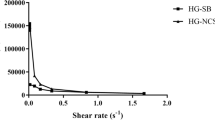Abstract
Cetirizine dihydrochloride (CTZ) is a second-generation histamine H1 antagonist, effective for the treatment of a wide range of allergic diseases. It has been utilized for managing the symptoms of chronic urticaria and atopic skin conditions. Thus, two novel semisolid formulations, nanoemulsion (NE) and hydrogel (HG) were developed to study their potential utility as vehicles including cetirizine (CTZ) and evaluate the potential use as topical H1-antihistamines agents. The physicochemical and stability properties of both vehicles were tested. Drug release kinetics and human skin permeation studies were performed using Franz cells. The antihistaminic activity was assayed in New Zealand rabbits and compared with two commercial first generation antihistamines. Both formulations were stable and provided a sustained drug release. Amounts of CTZ remaining in the skin were higher for HG, showing the maximum biological effect at 30 min, similar to topical first generation H1-antihistamines commercially available. These results suggest that CTZ-HG could be a promising system for the treatment of topical allergy bringing rapid antihistaminic relief.




Similar content being viewed by others
References
Assanasen P, Naclerio RM (2002) Antiallergic anti-inflammatory effects of H1-antihistamines in humans. Clin Allergy Immunol 17:101–139
Basketter D, Darlenski R, Fluhr JW (2008) Skin irritation and sensitization: mechanisms and new approaches for risk assessment. Skin Pharmacol Physiol 21:191–202
Cal K (2006) How does the type of vehicle influence the in vitro skin absorption and elimination kinetics of terpenes? Arch Dermatol Res 297:311–315
Calpena AC, Lauroba J, Suriol M, Obach R, Doménech J (1994) Effect of d-limonele on the transermal permeation of nifedipine and domperidone. Int J Pharm 103:179–186
Campos FF, Calpena Campmany AC, Delgado GR, Serrano OL, Naveros BC (2012) Development and characterization of a novel nystatin-loaded nanoemulsion for the buccal treatment of candidosis: ultrastructural effects and release studies. J Pharm Sci 101:3739–3752
Casiraghi A, Ardovino P, Minghetti P, Botta C, Gattini A, Montanari L (2007) Semisolid formulations containing dimethyl sulfoxide and alpha-tocopherol for the treatment of extravasation of antiblastic agents. Arch Dermatol Res 299:201–207
Chang C, Zhang L (2011) Cellulose-based hydrogels: present status and application prospects. Carbohydr Polym 84:40–53
Diepgen TL (2002) Long-term treatment with cetirizine of infants with atopic dermatitis: a multi-country, double-blind, randomized, placebo-controlled trial (the ETAC trial) over 18 months. Pediatr Allergy Immunol 13:278–286
Djekic L, Primorac M (2008) The influence of cosurfactants and oils on the formation of pharmaceutical microemulsions based on PEG-8 caprylic/capric glycerides. Int J Pharm 352:231–239
Escribano E, Calpena AC, Queralt J, Obach R, Domenech J (2003) Assessment of diclofenac permeation with different formulations: anti-inflammatory study of a selected formula. Eur J Pharm Sci 19:203–210
Moller P, Fall A, Bonn D (2009) Origin of apparent viscosity in yield stress fluids below yielding. Europhys Lett 87:38004–38009
Pader M (1993) Dentifrice rheology. In: Laba D (ed) The rheological properties of cosmetic and toiletries. Marcel Dekker, New York, pp 247–273
Pennick G, Harrison S, Jones D, Rawlings AV (2010) Superior effect of isostearyl isostearate on improvement in stratum corneum water permeability barrier function as examined by the plastic occlusion stress test. Int J Cosmet Sci 32:304–312
Ritger PL, Peppas NA (1987) A simple equation for description of solute release II. Fickian and anomalous release from swellable devices. J Control Release 5:37–42
Sandig AG, Campmany AC, Campos FF, Villena MJ, Naveros BC (2013) Transdermal delivery of imipramine and doxepin from newly oil-in-water nanoemulsions for an analgesic and anti-allodynic activity: development, characterization and in vivo evaluation. Colloids Surf B Biointerfaces 103:558–565
Savić S, Savić M, Tamburić S, Vuleta G, Vesić S, Müller-Goymann CC (2007) An alkylpolyglucoside surfactant as a prospective pharmaceutical excipient for topical formulations: the influence of oil polarity on the colloidal structure and hydrocortisone in vitro/in vivo permeation. Eur J Pharm Sci 30:441–450
Siepmann J, Peppas NA (2001) Modelling of drug release from delivery systems based on hydroxypropyl methylcellulose (HPMC). Adv Drug Deliv Rev 48:139–157
Solans C, Izquierdo P, Nolla J, Azemar N, Garcia-Celma MJ (2005) Nano-emulsions. Curr Opin Colloid. Interface Sci 10:102–110
Vermeulen B, Remon JP, Nelis H (1999) The formulation and stability of erythromycin-benzoyl peroxide in a topical gel. Int J Pharm 178:137–141
Vlastos D, Stephanou G (1998) Effects of cetirizine dihydrochloride on human lymphocytes in vitro: micronucleus induction. Evaluation of clastogenic and aneugenic potential using CREST and FISH assays. Arch Dermatol Res 290:312–318
Walsh GM (2002) Second-generation antihistamines in asthma therapy: is there a protective effect? Am J Respir Med 1:27–34
Wulff-Pérez M, Martín-Rodríguez A, Gálvez-Ruiz MJ, de Vicente J (2013) The effect of polymeric surfactants on the rheological properties of nanoemulsions. Colloid Polym Sci 291:709–716
Acknowledgments
The authors would like to thank to Gattefossé for kindly supplying the nanoemulsion ingredients used in this study and Hospital Barcelona-SCIAS (Barcelona, Spain) for providing skin samples.
Author information
Authors and Affiliations
Corresponding author
Electronic supplementary material
Below is the link to the electronic supplementary material.
Rights and permissions
About this article
Cite this article
Ciurlizza, C., Fernández, F., Calpena, A.C. et al. Semisolid formulations containing cetirizine: human skin permeation and topical antihistaminic evaluation in a rabbit model. Arch Dermatol Res 306, 711–717 (2014). https://doi.org/10.1007/s00403-014-1484-4
Received:
Revised:
Accepted:
Published:
Issue Date:
DOI: https://doi.org/10.1007/s00403-014-1484-4




